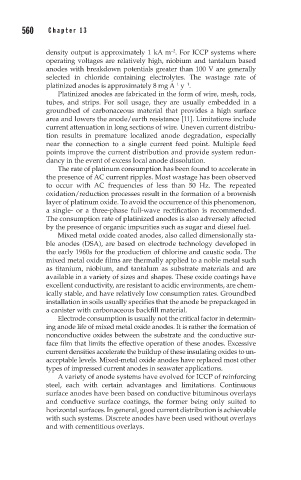Page 597 - Corrosion Engineering Principles and Practice
P. 597
560 C h a p t e r 1 3 C a t h o d i c P r o t e c t i o n 561
−2
density output is approximately 1 kA m . For ICCP systems where
operating voltages are relatively high, niobium and tantalum based
anodes with breakdown potentials greater than 100 V are generally
selected in chloride containing electrolytes. The wastage rate of
platinized anodes is approximately 8 mg A y .
−1
−1
Platinized anodes are fabricated in the form of wire, mesh, rods,
tubes, and strips. For soil usage, they are usually embedded in a
groundbed of carbonaceous material that provides a high surface
area and lowers the anode/earth resistance [11]. Limitations include
current attenuation in long sections of wire. Uneven current distribu-
tion results in premature localized anode degradation, especially
near the connection to a single current feed point. Multiple feed
points improve the current distribution and provide system redun-
dancy in the event of excess local anode dissolution.
The rate of platinum consumption has been found to accelerate in
the presence of AC current ripples. Most wastage has been observed
to occur with AC frequencies of less than 50 Hz. The repeated
oxidation/reduction processes result in the formation of a brownish
layer of platinum oxide. To avoid the occurrence of this phenomenon,
a single- or a three-phase full-wave rectification is recommended.
The consumption rate of platinized anodes is also adversely affected
by the presence of organic impurities such as sugar and diesel fuel.
Mixed metal oxide coated anodes, also called dimensionally sta-
ble anodes (DSA), are based on electrode technology developed in
the early 1960s for the production of chlorine and caustic soda. The
mixed metal oxide films are thermally applied to a noble metal such
as titanium, niobium, and tantalum as substrate materials and are
available in a variety of sizes and shapes. These oxide coatings have
excellent conductivity, are resistant to acidic environments, are chem-
ically stable, and have relatively low consumption rates. Groundbed
installation in soils usually specifies that the anode be prepackaged in
a canister with carbonaceous backfill material.
Electrode consumption is usually not the critical factor in determin-
ing anode life of mixed metal oxide anodes. It is rather the formation of
nonconductive oxides between the substrate and the conductive sur-
face film that limits the effective operation of these anodes. Excessive
current densities accelerate the buildup of these insulating oxides to un-
acceptable levels. Mixed-metal oxide anodes have replaced most other
types of impressed current anodes in seawater applications.
A variety of anode systems have evolved for ICCP of reinforcing
steel, each with certain advantages and limitations. Continuous
surface anodes have been based on conductive bituminous overlays
and conductive surface coatings, the former being only suited to
horizontal surfaces. In general, good current distribution is achievable
with such systems. Discrete anodes have been used without overlays
and with cementitious overlays.

